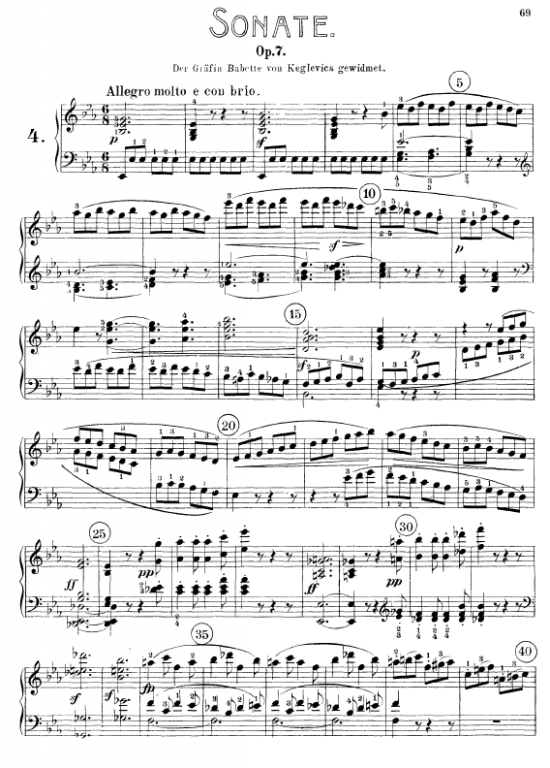Third Movement (Presto)
Form: Rondo-Sonata Form. A Minor.


EXPOSITION:
Bars 1-20: Principle Subject (first entry) in Tonic. The principle subject is a sixteen-bar sentence, in four-bar rhythm, prolonged to twenty bars by cadential repetition. The second phrase ends on a half-cadence, Bar 8; the fourth, with an interrupted cadence, Bar 16, and, on its repetition, with a full cadence, Bar 20.
Bars 21-63: Long modulating passage consisting of 8 bars in C major (relative major), leading to a variation of the Principle Subject in C minor and C major, greatly lengthened, and with frequent allusions in the latter portion to the key of D minor; the passage modulates finally to the key of E minor, in which it ends on a half-cadence in Bar 63. The sequential character of the whole of this passage, as of the greater portion of the movement, should be noted. Bars 56-57, in D minor, and Bars 58-59, in E minor, form a real sequence.
Bars 64-87: Melody (forming Second Subject) in E minor (Dominant minor) also a variation, taken by inversion, of the Principle Subject. This passage, when considered as a second subject, is unusual both in key and contents. In key, because in movements in the minor mode in regular Rondo-Sonata form, the second subject is always in the relative major. In its contents, it is unusual, because they include no fresh musical ideas whatever. For, not only does the passage commence with a variation of the principle subject – here also taken with inversions of parts – but, too, its continuation is founded entirely on a previous passage, transposed into the key of the dominant minor.
Bars 87-106: Connecting passage, overlapping, variously called Episode or Codetta. Note the sequence in the bass and inner part in the first eight bars of this passage, which ends on a half-cadence. Note also the chord of the chord of the Neapolitan sixth in the previous passage (Bar 75).
Bars 107-142: Principle Subject (second entry) in Tonic, followed by a modified reproduction of a portion of the previous Episode transposed into the key of the Tonic. The close of the exposition is exceptional. Instead of ending with the second entry of the principle subject, the latter leads without break into a modified reproduction, in the key of the tonic, of a portion of the previous episode. This is the only instance of the kind to be found in Mozart’s pianoforte sonatas.
Double bar.
DEVELOPMENT:
Bars 143-174: Episode in A major (Tonic major) in a “Hybrid” form. Although the essential characteristics of the “ternary” idea, vis., “divergence and recurrence,” the shape in which it is clothed closely resembles the binary. For though the “return” is not to the phrase, yet it is to the first half of the exposition i.e., to the second phrase of four. And the reappearance of the tonic pedal with which it is accompanied helps to strengthen the feeling of return to the opening portion of the melody. For the pedal, over which the first three phrases of the exposition are written, is discounted under the fourth – the final one. This episode is in the tonic major and starts with a fresh melody. It is, however, most interesting to note how intimately it is connected with Episode I. Compare the phrases. Bars 147-150, and Bars 25-28.
- A: New melody in A major modulating to E major (Dominant).
- B: Eight bars modulating sequentially through B minor to A major.
- A2: Repetition of a portion of the first sentence (i.e., the second of four phrases), modified so as to close with a full cadence in the Tonic.
RECAPITULATION:
Bars 175-194: Principle Subject (third entry) in Tonic (unaltered).
Bars 195-202: Passage of Transition. This passage starts in D minor and modulates to A minor, passing transiently through E major; Bars 195-198 thus form a short modulating sequence. The points of similarity and contrast between this passage and the earlier one (Bars 21-28) should be noted.
Bars 203-225: Second Subject in Tonic (modified). The latter portion of the recapitulation of the second subject is a slightly modified repetition of the corresponding portion of the original passage.
Bars 226-252: Coda. The Coda refers entirely to the exposition, but not to the principle subject.
First Movement (Allegro Maestoso)
Form: Sonata Form. A Minor.

EXPOSITION:
Bars 1-9: First Subject in Tonic. The first subject is an eight-bar sentence prolonged to nine by a sequential repetition of a motive in the second phrase. The first phrase is written entirely on a tonic pedal, over a continuation of which the second phrase opens.

Bars 9-22: Bridge-passage or Transition (overlapping). The transition overlapping the first subject, on which it is principally founded, starts as though that subject were commencing again. After three bars, however, it modulates to F major; thence – momentarily touching the keys of D major and C major – to C minor, in which key it ends on a half-cadence (Bar 22). The second subject is thus approached through the tonic minor of its own key. (See also first movement Sonatas No. XII and XV, both in F major).
Bars 22-45: Second Subject in C major (relative major). It is of interest to note that his only other sonata in the minor mode, viz., No. 14, in C minor, Mozart has also written the second subject in the key of the relative major. The second subject is divided into two sections (Bars 22-35 and 35-45). Note the melodic sequence in the opening bars of the second subject (Bars 23-25); and the sequence in all parts, Bars 28-29. The special point to notice in the second section of this subject is in the repetition of the melody, Bars 40-45, the greater part of which is inverted.
Bars 45-49: Codetta. The figures of the codetta are derived in the treble, from the opening bar of the movement, and in the bass, from a figure in the transition, Bar 11.
Double bar and repeat.
DEVELOPMENT:
Bars 50-79: After the first few bars, the development is worked entirely on two two-bar sections, the greater portion being developed from the opening bars of the first subject, and the latter part being founded on Bars 41-43 in the second subject.
It commences with the first phrase of the first subject transposed into the key of C major, modulating, in Bar 53, apparently to F major. The tonality of the next few bars is, however, vague, the music seeming to waver between the keys of F major and D minor. The chord which, in Bars 53 and 54, appears as the last inversion of the dominant minor ninth in F major in Bar 55, enharmonically changed to the first inversion of the dominant ninth in D minor. The reason for this alteration in notation is obscure, for the latter chord, like both the others, again resolves to the dominant seventh in F major. By further enharmonic change the last-named chord becomes, in Bar 57, the German sixth in E minor, and thus effects a modulation into that key. A most interesting passage commences in the following bar. It forms a real sequence, the “pattern” of which is four bars in length. This is worked with suspension on the figures derived form the first subject and is written throughout on successive dominant pedal points. It lasts twelve bars and passes through the keys of E minor (Bars 58-61), A minor (Bars 62-65), and D minor (Bars 66-70). N.B. – The only alteration in the “quality” of the interval occurs between the last two notes.
The remainder of the section is developed from the two bars of the second subject. Bars 70-72 form a descending sequence in which the figures appear in the treble to an accompaniment derived from the bass of the codetta. The sequence modulates to C major to A minor, on a half-cadence, in which key the section closes, Bar 79. In Bars 74-78, the figures are taken in the bass. A chromatic run (Bar 79) forms a link between the development and the recapitulation.
RECAPITULATION:
Bars 80-88: First Subject in Tonic.
Bars 88-103: Bridge-passage or Transition overlapping (varied and slightly lengthened). The first part of the transition reappears inverted and varied, its opening bars are founded on the first subject and are not, as in the first instance, a repetition of them. It is also slightly lengthened and modified so as to end in the key of the tonic.
Bars 103-129: Second Subject in Tonic.
The second subject divides into two section (Bars 103-116 and 116-129). The second subject reappears in the tonic in the original minor – not in the major mode. Note the chord of the Neapolitan sixth in A minor, Bars 109 and 119; also the inversion of the chromatic chord of the supertonic ninth in the same key, Bar 127.
Bars 129-133: Codetta in Tonic. There is no coda. The movement ends with the original codetta transposed into the key of the tonic.
Navigation etc.
| Piano Sonatas by Wolfgang Amadeus Mozart | |
|---|---|
|
|
Первое знакомство с Патетической сонатой
Фортепианная соната «Опус 13», более известная, как «Патетическая», безусловно, является одной из самых известных работ Людвига ван Бетховена.
Первую часть произведения узнает, наверное, любой человек, не занимающийся музыкой, а мелодия второй части и вовсе используется в произведениях современной поп-культуры.
Произведение часто используют в кинокартинах, в различных телевизионных передачах, его часто используют музыканты в своих так называемых «кавэр версиях» (интерпретируют сонату по-своему на самых разных музыкальных инструментах, в самых разных обработках и стилях) и так далее.
Из всех бетховенских фортепианных сонат, наверное, только «Лунная» сможет посоревноваться с «Патетической» в плане популярности среди людей, не являющихся фанатами классической музыки.
Слушать произведение
В общем, пора уже непосредственно знакомиться с произведением. Для этого предлагаем послушать данное произведение в исполнении замечательного пианиста, Валерия Вишневского:
Слушать часть 1:
Теперь, когда Вы послушали эту замечательную сонату, предлагаем рассмотреть самую основную информацию, которую неплохо было бы знать о данном произведении.
Сразу отметим, что проводить подробный музыкальный анализ данного произведения мы не будем, ибо его уже сотни раз проводили и гораздо более опытные музыковеды: Юрий Кремлев, Александр Гольденвейзер, Эдвин Фишер и другие.
Учитывая, что их материалы легко можно найти в сети, мы не будем изобретать колесо, ибо вряд ли сможем проанализировать данную сонату лучше, чем выше названные профессионалы.
Более того, нас читают в большинстве случаев не профессиональные музыканты, а самые разные люди, не особо знакомые с музыкальной терминологией, которые просто хотят познакомиться с творчеством Бетховена. Именно для последних было бы полезным ознакомиться со следующей информацией.
Когда была написана?
Нам точно известная дата, когда издатель Франц Антон Хоффмайстер опубликовал «Патетическую сонату» — это было 18 декабря 1799 года.
Считается, что незадолго до этого, произведение было впервые опубликовано другим издателем — Йозефом Эдером. Однако, по другим данным, Хоффмайстер опубликовал произведение раньше Эдера. Точную дату опубликования произведения Эдером мы не знаем и, следовательно, гадать на кофейной гуще не будем.
Но это актуально, если мы говорим об издании произведения. Ну а, если мы говорим о, собственно, временных рамках работы над его сочинением самим композитором, то традиционно считается, что Бетховен написал Патетическую сонату за год до ее опубликования — то есть, в 1798 году.
Стоит отметить, что некоторые, найденные исследователями эскизы говорят нам о том, что первые наброски фрагментов Патетической сонаты велись чуть ли ни с 1796 года.
Известный бетховеновед Барри Купер, в свою очередь, продлил гипотетическую дату окончания композитором работы над этим произведением аж до октября 1799 года. Возможно, именно тогда Бетховен внес в сонату самые последние штрихи.


































